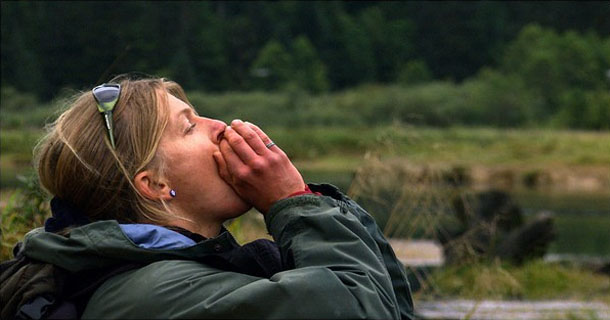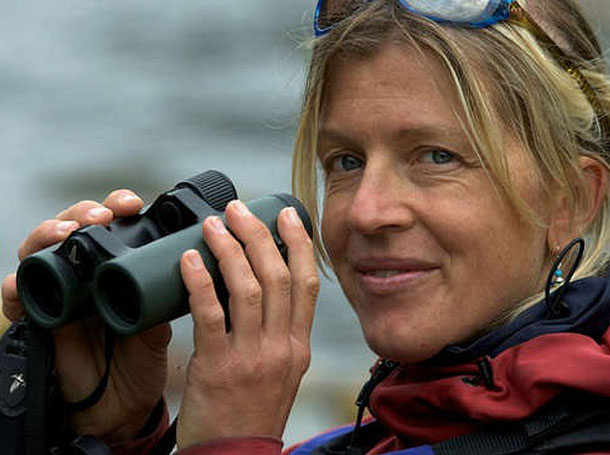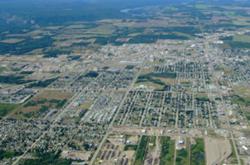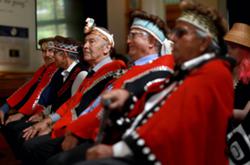[Editor's note: In 2005, elite marathon mountain runner and cross-country skier Gudrun Pflüger spent five weeks tracking and studying elusive coastal wolves by foot, kayak and sailboat along the rugged Pacific Coast of western Canada. Her work as a field biologist eventually formed the basis for the Smithsonian Channel documentary A Woman among Wolves.
Before the film aired, Pflüger was diagnosed with brain cancer and told she would be dead in 18 months. Surgeons removed a tumour the size of a golf ball, and Pflüger underwent protracted chemotherapy and other treatments. Determined to live, Pflüger took the wolf -- a true "endurance athlete" -- as a model and this time immersed herself in the mountain backcountries of British Columbia and Alberta, which led to another Smithsonian Channel documentary, Running with Wolves. Defying the odds and astounding her doctors, Pflüger became a mother, giving birth to a son, Conrad, in 2009.
The following is drawn from Wolf Spirit: A Story of Healing, Wolves and Wonder by Gudrun Pflüger, published by Rocky Mountain Books, whose titles the Tyee is spotlighting this week with a series of excerpts.]
What comes to mind when you hear the word "wolf?" Red Riding Hood and dark forests? Sharp teeth and danger? Unmodern creatures that no longer have a place in our contemporary society and landscape?
Or do you think of a gentle encounter that can save your life?
This is my story. Thanks to wolves, I was able to perceive my love of life, strengthen my will to survive, and nourish my respect for all life.
Without my intense experiences in the wilderness, which often brought me to my very limits, I wouldn't have known how far my own strengths extend and where they actually come from. In untamed nature, I learned to respect that which is uncontrollable, to accept it, and finally recognize it as an essential part of my own life.
I. COAL
Coal has disappeared yet again. This dark wolf is really keeping me on my toes. He is the champion roamer among our tagged wolves. Here today, tomorrow almost 80 kilometres farther south. How on earth does he do that, especially with a paw that's missing a toe? He sacrificed it when he stepped into a foothold trap -- he chewed it off so he could continue to live freely. Since then he has roamed along the foothills on the eastern flank of the Rockies. In addition to the night watches south of Kananaskis Country, I try to keep up with Coal during the day. This means refilling my gas tank often.
For months, Coal has been demonstrating to us what a wolf is capable of. For me he is the prime example of a wolf, and he is unfortunately also experiencing the typical story for the wolves in this area: permanently looking for something, constantly on the run. He knows every tree along the foothills, but he has never found a place to call home.

All spring, I've followed Coal for hundreds of kilometres without ever seeing him. He is the embodiment of humans' hatred of the uncontrollable; we project our acute discomfort onto him. As soon as he appears, he's already gone again. He corresponds perfectly to the myth of the spectral wolf.
Over the months, I develop a deep feeling of sympathy toward him. Through him I've learned that it's not always necessary to have someone very close and constantly in view in order to build a relationship. I've also learned that it's important to always meet your counterpart with respect, which can be expressed to a wolf with spatial distance. Only then do you get a true picture of him; his tracks are undistorted, the way he determines with his free will.
And it was with Coal, this wolf I so greatly respect and admire, with his adroit cleverness, that I once overstepped that respectful boundary. This remains even today the experience I most regret.
Accidental prey
I locate Coal's signal in the steep flanks of the Livingstone Range. From the dusty gravel road I'm driving along, I get an excellent bearing. I immediately pull over onto the shoulder, jump out of the car, throw my backpack over my shoulder and walk over the last patches of snow, slowly disappearing under the warm spring sunshine, directly toward the signal. The volume assures me that I'm still far enough away that the wolf won't notice me. But the signal quickly grows louder.
I begin to move forward by creeping from cover to cover. Then I come across his trail. Clearly pressed into the snow, it leads diagonally up the steep northern slope. The snow becomes very deep; here the land is covered by a permanent shadow in winter. In places it's so steep that Coal worked his way upward in bounds. Even without a signal, this track would have let me know that it's him: one paw print has three toes. And at regular intervals, I find some blood in it.
I'm up to my hips in snow at some points. It's obvious that this slope is prone to avalanche. Now at the latest I should have turned around, but that only became clear to me after the fact. I know everything I need to know for my monitoring. And Coal is on land that is part of a ranch whose owners are pro-wolf. So he is safe here and should stick around as long as possible.
But instead I tramp onward. The steepness of the terrain and the depth of the snow make it impossible to check Coal's signal regularly. Finally, I reach a small grove of dwarf birch trees outside the avalanche channel. The terrain is somewhat flatter here. I catch my breath and take another reading. He is very close, so close that the attenuator, the signal that you only receive in the immediate vicinity of the transmitter, sounds. He must be crouched there in the grove in front of me. All at once my adrenaline level plunges and a sudden, sobering awareness comes to me. I come to my senses. I've been chasing him, urging him on ahead of me. This wolf, the one whose ghost-like quality and endurance in the face of all kinds of dangers I so admire -- I hunted down this wolf.
Yet again, in the deep snow and steep terrain, he was forced to demonstrate his will to live and wrote it in the snow with his blood. Suddenly I start to cry, from exhaustion, but especially out of sympathy for Coal. I'm disappointed in myself for not being able to resist the greedy desire to finally see Coal with my own eyes, a desired result that comes at the expense of this wolf that has already been severely persecuted. Now he has to flee one more time. For me, it is a new, singular and sad experience.
I begin to talk with him, slowly apologizing toward the brush in which two attentive ears are hidden. I continue to talk soothingly as I slowly make my retreat. Coal should know that I'm not one of them.
When I reach the car again, I feel the full force of the spring sun. I blink up at the shadowy, cold slope where Coal, the wolf, can now find some peace.
A few months later he is chased for the last time. The pursuit ends fatally for Coal.
II. ICY
When I'm out tracking, I'm in the moment. I feel myself completely in the here and now, and thoroughly alive. The wolves take me to places I would never have gone otherwise, they show me things I would never have perceived, and they open boundaries for me that I would otherwise never have crossed. They convey a certain single-mindedness, sometimes almost an indifference, toward challenges. They make my life richer.
This November evening, I can feel the effects of the day's long hike in my muscles, but I am back out in the field -- and I'm fighting sleepiness. Just don't fall asleep, don't fall asleep, don't fall... Suddenly I'm awoken by loud motor sounds. As if hit by a bolt of lightning, I'm immediately wide awake. Here come two pairs of headlights directly toward my truck. Which is parked miles away from any public road in a vast expanse of grazing grounds. Who can it be?

It's shortly after 3:00 am. I break out in goosebumps. Oh, lord. Right. Around 11:00 pm, a couple of hunters had stopped by the trailer in Alberta's Highwood park that serves as my base. They'd arrived with Heigh, whose job is to patrol, by vehicle and on horseback, a nearby cattle ranch. The hunters, also ranch riders, had tried to insist that I join them at the pub in Longview to share a drink to celebrate their successful elk hunt. I'd told them I was working right then, and they could bring me a beer on their way home.
These guys had clearly already had a few even before their trip to the pub, so I was sure they would forget all about me. Now I regret having said that bit about bringing me a beer. Because at this moment, a group of drunken hunters is staggering toward me in the middle of the night, in the middle of nowhere. I want to start the truck, but it doesn't make a sound. Dammit. I fell asleep with the lights on; the battery is empty. Now I even need their help!
The first one is already laying on the horn of his pickup and yanks my door open. Grinning, he pulls a bottle of beer from the side pocket of his denim jacket. I fall back in my seat, take a deep breath and release a disbelieving, "Wow -- didn't think you guys..." I don't get any further. With an awkward move, he pulls himself into the cabin of my truck, at the same time pushing me onto the passenger's seat.
"Doesn't start, eh?"
"Empty battery," I mutter.
"Hey, Joe, we need the jumper cables! Toss them over!" In no time, the ranch riders have my truck running again.
I sit with wide-open eyes next to my uninvited chauffeur. "And what now?"
"It's probably best to drive you to our hunting cabin back there in the woods. You must be cold. And have you eaten anything tonight?"
"Well, yeah, I ate something..."
"Too long ago. We'll make you something warm. Hey, Heigh, the lady's hungry -- fire up the barbecue!"
When the hunting cabin appears in the headlights, I recognize the bodies of two large animals next to it, hanging with spread legs from a thick, round beam. An elk and a moose, which look gruesome in that condition. Like a gentleman, one of the hunting heroes gives me a hand as I jump down from the truck.
Heigh is already heating up the barbecue grill on the small front terrace. Then I see the actual bounty from the pub squirming their way out of the second truck: two bleached-blond cowgirls, wearing jeans tighter than their own skin. Oh no, what have I gotten myself into again? Furtively, I look around for my truck. Should I just take off? It's blocked by the other vehicles.
'Damned beasts'
My dinner is ready. Steak and canned peach preserves. The steak blows my mind, so juicy and perfectly grilled. I note that I was genuinely hungry and throw Heigh a look of appreciation. The ranch rider responds with a question: "Why do you do that?" He means my job studying, and seeking to conserve, wolves on the cattle pastures.
Okay, I think to myself, that was the opening shot, and I can already picture myself hanging next to the two wild animals outside the cabin. And to top everything off, today of all days, I'm wearing the red T-shirt bearing one of those kitschy, romanticized images of a wolf. So I decide to plunge straight ahead and start the first lesson: the facts of wolf biology. Then I explain in simple terms why I do this "crazy" work and try to explain to him that wolves only attack cattle because shooting kills some of their numbers randomly, which hugely interferes with their social structure and their ability to hunt wild prey.

As I talk, I avoid direct references to the current situation of this particular herd and these particular men, who are sitting tightly crowded around a small, battered wooden table with me in the cabin. But I do also talk about agriculture where I grew up in the Austrian Alps, various types of Austrian beer, and cross-country skiing. Everyone listens with remarkable respect. Then Heigh starts to talk: "Sorry, Gudrun, but I hate wolves. I kill every one I can get."
"You know," he continues, "I'm out there and help the newborn calves plow their way through the deep, heavy spring snow to their mothers to nurse. And then the next day I see the calves standing there with their intestines hanging out. Oh my God, how I hate those damned beasts."
I nod. And start over from the beginning: "Yeah, we don't want either one, dead calves or dead wolves. That's why we're trying to test different, non-lethal methods that are intended to minimize the killing of cattle. Whether that's night watches or putting up fladgery -- lines with strips of red cloth hanging from them, which wolves won't cross -- or using more barns in cattle farming or cutting back on the hunting of wolves' natural prey, like elk and deer, in areas where cattle herds are affected."
It occurs to me that no one at this table has ever given a thought to the wolf, except that it should be eradicated. Thanks to the ever-present fascination that wolves exert on anyone who has at least a little objective information about their social structure, family life, communication or hunting strategies, I, too, have interested listeners.
After a brief silence, someone suddenly says, "Hey, Joe, that's right! That's goddamn right!"
I will never forget that exclamation; I carry it in me as a constant spark of hope that is always rekindled when it seems we're talking to brick walls of human prejudices. For me, this outcry represents the ever-present possibility of changing people's minds, the power of mutual respect and building bridges, and the opportunities that come about when we focus on what we have in common instead of what separates us. In the course of my work on behalf of wolves, I have repeatedly experienced similar "Aha!" moments of insight with wolf killers. Often they aren't even antagonistic toward wolves, they just kill wolves out of habit.
Wolves are simply animals. But as soon as we start to use them as a surface on which to project our own fears and weaknesses, they become problematic animals that need to be driven away or even exterminated.
I'm back in the cattle pasture in time for the sunrise. Everything is calm. Thank heavens. I wait for the next critical hour to pass, then start to make my way back toward the Highwood trailer. Tired but impressed, I'm sitting at the steering wheel when Heigh, already on his morning patrol of the cattle, rides toward me. He signals to me that I should stay put. I roll down the window and wait. "Gudrun, I want to apologize for last night. I was a little bent out of shape about the whole wolf thing." I smile. At him and inwardly. The ice has been broken.
III. WILD SOULS
I don't own a clock, and in the wilderness of Canada and during my illness, time played no role at all; there was only being or no-longer-being.
While I struggled with my illness, I coined the term "wolf spirit" to unite all the powerful qualities of wolves -- their determination and endurance, their cohesiveness as a team, their joy, and their will to live. When I identified with the wolf spirit, I was successful in my own healing.
We urgently need to do everything in our power to preserve the natural habitats that still exist, not only for the sake of biodiversity but also for the well-being of our own souls. All our life force has its origins in unfettered nature. This message is, for me, inseparably connected with the wild, free-roaming wolves of Canada. ![]()
Read more: Environment

















Tyee Commenting Guidelines
Comments that violate guidelines risk being deleted, and violations may result in a temporary or permanent user ban. Maintain the spirit of good conversation to stay in the discussion.
*Please note The Tyee is not a forum for spreading misinformation about COVID-19, denying its existence or minimizing its risk to public health.
Do:
Do not: